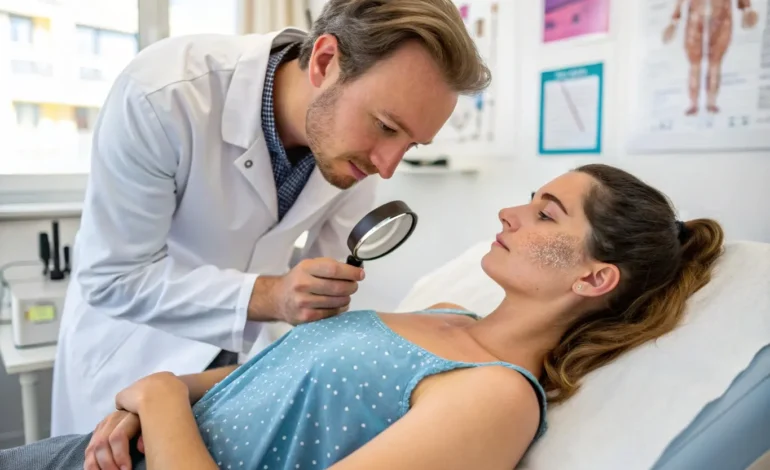Moles: What Your Skin Might Be Trying to Tell You — And When to Pay Attention
Are your moles safe? Learn what to look for, when to worry, and how to tell if a mole could be cancerous. Expert advice, risk factors, and prevention tips.

They seem harmless. A tiny dot on your arm, a dark patch behind your ear, a small bump you’ve had since childhood. But under the right (or wrong) circumstances, a mole can be far more than a cosmetic concern — it can be a warning sign.
Across the world, millions of people have moles. Some have a few. Others have dozens. And while most are benign, a small percentage can evolve into something far more dangerous: melanoma, the deadliest form of skin cancer.
But what actually is a mole? How do they form? And what signs should you never ignore?
What Is a Mole, Really?
A mole (also called a nevus) is a cluster of melanocytes, the skin cells responsible for producing pigment. They appear as brown, black, or even pink or skin-colored spots and can be flat or raised.
Most people develop moles during childhood or early adulthood. Some are genetic. Others appear from sun exposure. And while most remain unchanged for life, a few can become dangerous.
“The average adult has between 10 and 40 moles,” says Dr. Alicia Kim, a board-certified dermatologist in New York. “But if you have more than 50, your risk of melanoma increases significantly.”
Why Do Moles Form?
There are several reasons why moles develop, including:
- Genetics: If your parents had many moles or atypical ones, you’re more likely to as well.
- Hormones: Puberty and pregnancy can trigger the formation of new moles or changes in existing ones.
- Sun exposure: UV radiation stimulates melanocytes, which can cause new moles or change existing ones.
- Skin type: People with fair skin are more likely to develop both moles and skin cancer, but no one is immune.
What If You Have Many Moles?
Having multiple moles isn’t dangerous on its own — but it can increase your lifetime risk of developing skin cancer.
If you have:
- More than 50 moles, or
- Atypical (dysplastic) moles that are large, uneven, or multicolored,
…you should get regular skin checks with a dermatologist. According to the Skin Cancer Foundation, people with many moles are up to 12 times more likely to develop melanoma than those with few moles.
“I had over 80 moles by the time I was 30,” says Maria Lopez, a skin cancer survivor from Austin, TX. “One day I noticed one had changed shape. It turned out to be stage 1 melanoma — and I caught it just in time.”
Can You Tell If a Mole Is Dangerous?
Yes — if you know what to look for. Dermatologists use the ABCDE rule to spot signs of a potentially cancerous mole:
- A — Asymmetry: One half doesn’t match the other.
- B — Border: Irregular, scalloped, or poorly defined edges.
- C — Color: Multiple colors, or unusual shades like red, white, or blue.
- D — Diameter: Larger than 6mm (about the size of a pencil eraser).
- E — Evolving: Changing size, shape, or color over time.
“Any mole that suddenly starts to itch, bleed, hurt, or grow should be evaluated immediately,” says Dr. Kim. “Those changes can signal something serious.”
Can Moles Hurt?
Most moles are painless. But if a mole starts hurting, itching, bleeding, or becomes raised suddenly, it’s a red flag. While pain doesn’t always indicate cancer, it’s not something to ignore.
If you have a mole that feels sore to the touch, appears inflamed, or forms a scab, book a dermatologist appointment as soon as possible.
Read About: When a Wart Won’t Go Away: My Daughter’s Battle With a Stubborn Skin Virus and What Every Family Should Know
Can Moles Be Removed?
Yes — and safely.
Dermatologists can remove moles for medical or cosmetic reasons using:
- Shave excision (for surface-level moles)
- Surgical excision (for deeper or suspicious moles)
- Laser removal (less common for atypical moles)
Important: Never attempt to cut off or burn a mole at home. This is dangerous and can lead to infection, scarring, or a missed diagnosis.
Are Some Races More Affected?
Yes, but the danger is more hidden in some groups.
While fair-skinned individuals are at higher risk for melanoma, people with darker skin are often diagnosed later — and suffer higher mortality rates. That’s because signs can appear in less obvious places: under nails, on palms, or soles of feet.
“Everyone, regardless of race or skin tone, needs to check their moles and know what’s normal for their body,” says Dr. Kim.
Can Moles Be Prevented?
Not entirely — but you can reduce risk factors for harmful changes:
- Use sunscreen daily (SPF 30 or higher)
- Avoid tanning beds
- Wear protective clothing outdoors
- Perform monthly skin checks at home
- Get a professional skin exam once a year, or more if you’re high-risk
When to Get Help
If you notice any of the following, see a dermatologist right away:
- A new mole after age 30
- A mole that changes shape, color, or size
- Pain, itching, or bleeding
- A mole that looks noticeably different from others (aka “ugly duckling”)
“Your skin is the largest organ of your body — and sometimes, the smartest,” Dr. Kim adds. “It tells you when something’s wrong. You just have to listen.”
New Perspectives
Moles are more than marks. They’re messengers — sometimes harmless, sometimes life-saving. Learning what to look for and when to act can turn fear into early detection, and uncertainty into peace of mind.Because when it comes to skin cancer, early is everything.
Your body knows the signs. Now, so do you.








